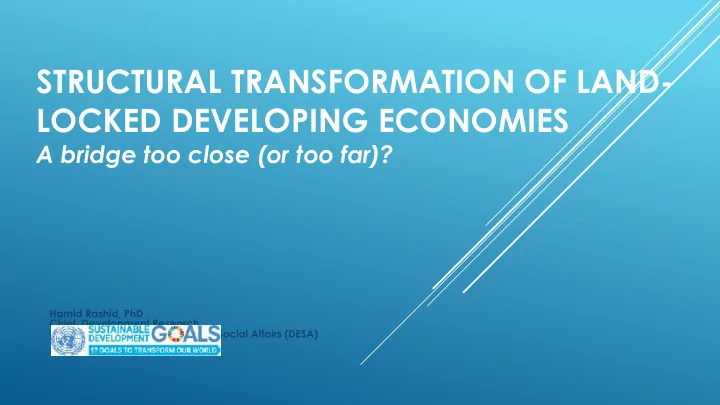

STRUCTURAL TRANSFORMATION OF LAND- LOCKED DEVELOPING ECONOMIES A bridge too close (or too far)? Hamid Rashid, PhD Chief, Development Research UN Department of Economic and Social Affairs (DESA)
REMOTENESS: A DISADVANTAGE? � Not entirely � Opportunities for creating robust domestic market � Resilience to fluctuations to business cycles, shocks and contagion � Leapfrogging � Avoid the pain of premature deindustrialization � But remoteness matters for something more important
WHAT DRIVES STRUCTURAL TRANSFORMATION? � Structural transformation – moving people from low-skilled, low productivity and low- value added sectors to higher-skilled, higher productivity and higher value-added sectors � Key driver: productivity growth � But what drives productivity growth � International trade and competition � Demand for skills � Physical investments � Public policy � Quality of human capital � Quality of institutions � Initial conditions - inequality � Trade and global integration are necessary but NOT sufficient for productivity growth and structural transformation
INEQUALITY: A BINDING CONSTRAINT TO PRODUCTIVITY GROWTH AND STRUCTURAL TRANSFORMATION � Inequality matters more than we knew � Growth-inequality trade-offs debunked – inequality is not a necessary evil for achieving faster growth � Growth evidence shows inequality hurts growth through productivity channels � Inequality directly hurts productivity growth � High inequality and low social mobility discourages education and skills accumulation � Low levels of human capital discourages investment � Inequality also hurts growth indirectly � Erodes trusts in institutions � Inequality amplifies uncertainties and sense of insecurity � Makes contract enforcements difficult � Increases transaction costs in businesses � Discourages investment
INCOME INEQUALITY IS SIGNIFICANTLY HIGHER IN LAND-LOCKED DEVELOPING ECONOMIES ➢ Should not surprise us - excessive dependence on natural resource exports and “resource curse” largely explain high levels of income inequality in LLDCs ➢ But worrisome, inequality continues to rise in many LLDCs ➢ What we need to remember – countries that achieved rapid structural transformations during the past seventy years began with very low level of income inequality
A VICIOUS OR VIRTUOUS CYCLE? ➢ Inequality is not an act of nature ➢ It is a matter of public policy choice ➢ LLDCs must combat and reverese inequality to spur productivity growth and structural transformation
Recommend
More recommend